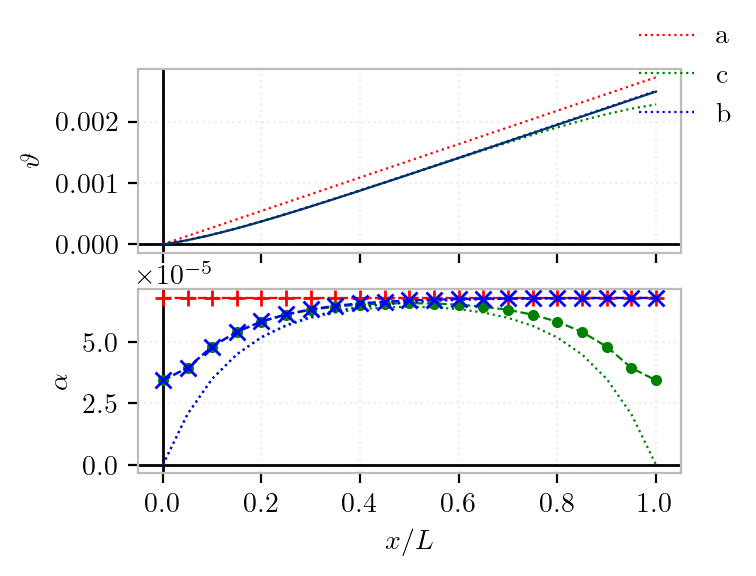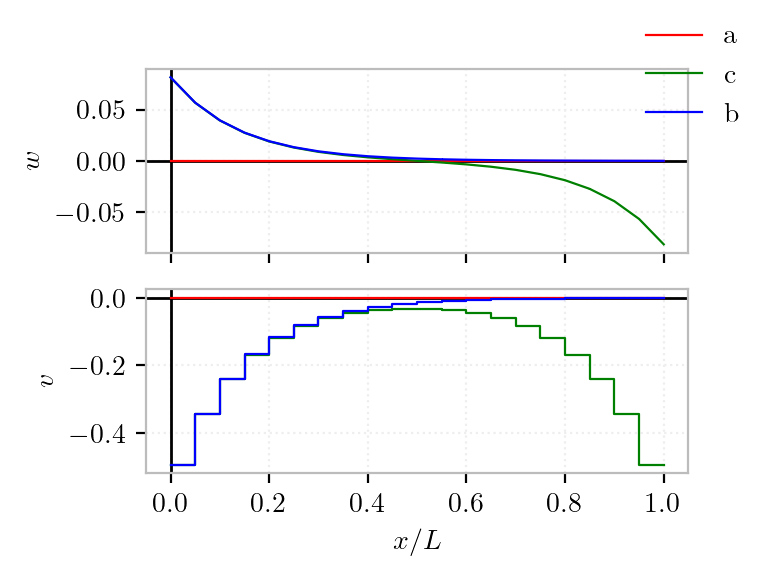0011 - Restrained torsion
4 min read • 653 wordsLinear 7-DOF analysis of a cantilever subjected to a torque.

Consider a W21x93 section.
See also Veronique, Armero
# Test of the warping DOF
# Linear 7-DOF analysis of a cantilever subjected to a torque
#
import os
import sys
import veux
from veux.motion import Motion
from xsection.library import WideFlange, HollowRectangle, Channel, Rectangle, Circle
import opensees.openseespy as ops
# External libraries
import numpy as np
import matplotlib.pyplot as plt
try:
plt.style.use("veux-web")
except:
pass
def create_cantilever(aspect,
shape,
case="a",
element="ExactFrame",
section="Elastic"):
E = 29e3 # ksi
v = 0.30 #0.5*E/G - 1
G = 0.5*E/(1+v) # 11,200 ksi
L = shape.d/aspect #240
ne = 20 # 20
nen = 2
nn = ne*(nen-1)+1
model = ops.Model(ndm=3, ndf=7)
model.eval(f"set E {E}")
model.eval(f"set G {G}")
model.eval(f"set L {L}")
mat = 1
sec = 1
model.material('ElasticIsotropic', mat, E, v)
if section == "Elastic":
cmm = shape.cmm()
cnn = shape.cnn()
cnv = shape.cnv()
cnm = shape.cnm()
cmw = shape.cmw()
A = cnn[0,0]
model.section("ElasticFrame", sec,
E=E,
G=G,
A=A,
Ay=1*A,
Az=1*A,
Qy=cnm[0,1],
Qz=cnm[2,0],
Iy=cmm[1,1],
Iz=cmm[2,2],
J =shape.torsion.torsion_constant(),
Ry= cnv[1,0],
Rz=-cnv[2,0],
Sy= cmw[1,0],
Sz=-cmw[2,0]
)
else:
model.section("ShearFiber", 1, GJ=0)
for fiber in shape.create_fibers():
model.fiber(**fiber, material=mat, section=1)
model.geomTransf("Linear", 1, (0,0,1))
for i,x in enumerate(np.linspace(0, L, nn)):
model.node(i, (x,0,0))
for i in range(ne):
start = i * (nen - 1)
nodes = list(range(start, start + nen))
model.element(element, i+1, nodes, section=1, transform=1, shear=1)
wi = int(case in "cb")
wj = int(case in "c")
model.fix(0, (1,1,1, 1,1,1, wi))
model.fix(nn-1, (0,0,0, 0,0,0, wj))
return model, shape
if __name__ == "__main__":
slenderness = 0.5
th = 0.05 #0.05
depth = 20
# shape = Channel(
# tf=th*depth,
# tw=th*depth,
# d=depth,
# b=depth*0.4,
# mesh_scale=1/400 #800
# )
# shape = shape.translate(shape._analysis.shear_center())
# shape = Rectangle(d=depth, b=0.4*depth, mesh_scale=1/200)
# shape = Circle(depth/2, divisions=8, mesh_scale=1/200)
# # W21x93
# shape = WideFlange(
# tf = 0.93,
# tw = 0.58,
# d = 21.62,
# b = 8.42,
# mesh_scale=1/200
# )
shape = HollowRectangle(
tf = th*depth*2,
tw = th*depth,
d = depth,
b = depth*0.4,
mesh_scale=1/200
)
print(shape.summary())
fig, ax = plt.subplots()
_, (ax2, ax3) = plt.subplots(2, 1, sharex=True)
_, (ax4, ax5) = plt.subplots(2, 1, sharex=True)
ax2.set_ylabel(r"$\vartheta$")
ax2.axvline(0, color='black', linestyle='-', linewidth=1)
ax2.axhline(0, color='black', linestyle='-', linewidth=1)
ax3.set_xlabel("$x/L$")
ax3.set_ylabel(r"$\alpha$")
ax3.axvline(0, color='black', linestyle='-', linewidth=1)
ax3.axhline(0, color='black', linestyle='-', linewidth=1)
ax4.set_ylabel(r"$w$")
ax4.axvline(0, color='black', linestyle='-', linewidth=1)
ax4.axhline(0, color='black', linestyle='-', linewidth=1)
ax5.set_ylabel(r"$v$")
ax5.axvline(0, color='black', linestyle='-', linewidth=1)
ax5.axhline(0, color='black', linestyle='-', linewidth=1)
ax5.set_xlabel("$x/L$")
ax.set_xlabel(r"Twist, $\vartheta$")
ax.set_ylabel("Torque, $T$")
# ax.set_xlim([0, 2])
# ax.set_ylim([0, Mmax])
ax.axvline(0, color='black', linestyle='-', linewidth=1)
ax.axhline(0, color='black', linestyle='-', linewidth=1)
for case in "acb":
model, shape = create_cantilever(slenderness, shape, case,
section = os.environ.get("Section", "ShearFiber"),
element = os.environ.get("Element", "ExactFrame"))
end = len(model.getNodeTags()) - 1
L = model.nodeCoord(end, 1)
# Apply torsional moment
nsteps = 15
Mmax = 1.2e3
model.pattern("Plain", 1, "Linear")
# model.load(0 , (0,0,0, 0,0,0, -1e-3), pattern=1)
model.load(end, (0,0,0, 1,0,0, 0), pattern=1)
model.system('Umfpack')
model.integrator("LoadControl", Mmax/nsteps)
model.test("NormDispIncr", 1e-12,5,1)
# model.test('NormUnbalance',1e-6,10,1)
model.algorithm("Newton")
model.analysis("Static")
u = []
P = []
while model.getTime() < Mmax:
u.append(model.nodeDisp(end, 4))
P.append(model.getTime())
if model.analyze(1) != 0:
print(f"Failed at time = {model.getTime()}")
break
model.reactions()
x = np.array([model.nodeCoord(node, 1) for node in model.getNodeTags()])
marker = "+x."["abc".index(case)]
color = "rbg"["abc".index(case)]
ax.plot(u, P, marker, color=color, label=case)
twist = [model.nodeDisp(node,4) for node in model.getNodeTags()]
ax2.plot(x/L, twist, ":", color=color)
ax3.plot(x/L,
[model.nodeDisp(node,7) for node in model.getNodeTags()],
":",
color=color,
label=case
)
rate = np.gradient(twist, x)
ax3.plot(x/L, rate, marker+"--", color=color)
xs = [(x+model.nodeCoord(model.eleNodes(tag)[0], 1))/L for tag in model.getEleTags() for x in model.eleResponse(tag, "integrationPoints")]
ws = [
model.eleResponse(tag, "section", i+1, "resultant")[6]/(Mmax*L)
for tag in model.getEleTags()
for i in range(len(model.eleResponse(tag, "integrationPoints")))
]
ax4.plot(xs, ws, "-", color=color, label=case)
vs = [
model.eleResponse(tag, "section", i+1, "resultant")[9]/Mmax
for tag in model.getEleTags()
for i in range(len(model.eleResponse(tag, "integrationPoints")))
]
ax5.plot(xs, vs, "-", color=color)
#
# Plot the analytical solution
#
G = 11.2e3
E = 29e3
J = shape._analysis.torsion_constant()
Cv = shape.cvv()[0,0]
Cw = shape.cww()[0,0]
eta = 1 + J/Cv
lam = np.sqrt(G*J/(eta*E*Cw))
x = np.linspace(0,L,100)
aL = L*Mmax/(G*J)
a0 = L*Mmax/(G*J)*(eta - 1)/eta
a = aL*x/L + (a0 - aL)*np.tanh(lam*L)/(lam*L)*(1 - np.sinh(lam*L*(1 - x/L))/np.sinh(lam*L))
ax2.plot(x/L, a)
ax.figure.legend()
ax3.figure.legend()
ax4.figure.legend()
fig.savefig("img/e0011.png")
ax3.figure.savefig("img/e0011-kinematics.png")
ax4.figure.savefig("img/e0011-resultants.png")
plt.show()


